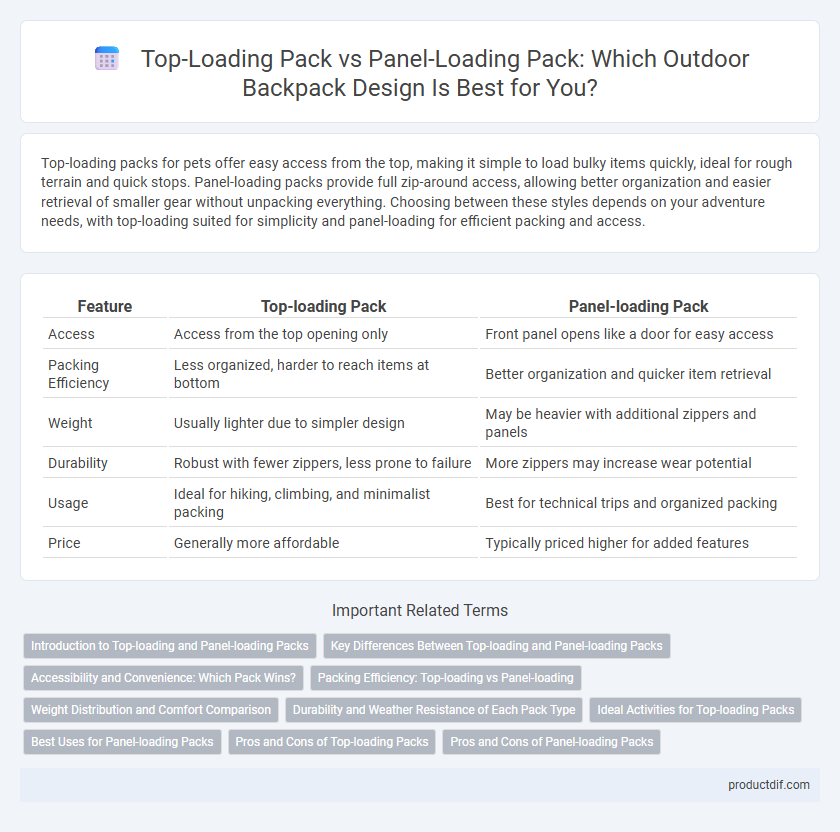Top-loading packs for pets offer easy access from the top, making it simple to load bulky items quickly, ideal for rough terrain and quick stops. Panel-loading packs provide full zip-around access, allowing better organization and easier retrieval of smaller gear without unpacking everything. Choosing between these styles depends on your adventure needs, with top-loading suited for simplicity and panel-loading for efficient packing and access.
Table of Comparison
| Feature | Top-loading Pack | Panel-loading Pack |
|---|---|---|
| Access | Access from the top opening only | Front panel opens like a door for easy access |
| Packing Efficiency | Less organized, harder to reach items at bottom | Better organization and quicker item retrieval |
| Weight | Usually lighter due to simpler design | May be heavier with additional zippers and panels |
| Durability | Robust with fewer zippers, less prone to failure | More zippers may increase wear potential |
| Usage | Ideal for hiking, climbing, and minimalist packing | Best for technical trips and organized packing |
| Price | Generally more affordable | Typically priced higher for added features |
Introduction to Top-loading and Panel-loading Packs
Top-loading packs feature a single main compartment accessed from the top, providing a lightweight and simple design favored for bulkier gear and long hikes. Panel-loading packs open like a suitcase with a large front panel, allowing easy organization and quick access to contents without unpacking everything. Choosing between these pack types depends on the balance between accessibility and efficient weight distribution for outdoor adventures.
Key Differences Between Top-loading and Panel-loading Packs
Top-loading packs feature a single main compartment accessed from the top, offering a simpler design and typically better water resistance due to fewer openings. Panel-loading packs provide a front-facing zipper that allows full access to the main compartment, enhancing organization and easy packing or unpacking. Key differences include accessibility, organization options, and weather resistance, influencing the choice based on hiking style and gear needs.
Accessibility and Convenience: Which Pack Wins?
Top-loading packs provide straightforward access through a single, large opening, making them ideal for bulk storage but less convenient for quick item retrieval. Panel-loading packs feature zippered front panels that allow users to access gear more easily and organize belongings efficiently, enhancing convenience during outdoor activities. For accessibility and on-the-go convenience, panel-loading packs generally outperform top-loading designs.
Packing Efficiency: Top-loading vs Panel-loading
Top-loading packs offer superior packing efficiency for bulky, irregularly shaped gear by allowing flexible layering from the top, maximizing vertical space utilization. Panel-loading packs provide quick and organized access to items through a front zippered panel, ideal for systematic packing but potentially limiting vertical space optimization. Choosing between the two depends on the balance between ease of access and maximum storage efficiency for your outdoor adventures.
Weight Distribution and Comfort Comparison
Top-loading packs provide superior weight distribution by allowing gear to be packed centrally and closely to the back, enhancing balance on uneven terrain. Panel-loading packs offer easier access to items without unpacking the entire bag but can lead to less efficient weight distribution, potentially causing discomfort during long hikes. Comfort in top-loading designs generally exceeds panel-loading models due to reduced shifting of weight and better load stability.
Durability and Weather Resistance of Each Pack Type
Top-loading packs typically offer superior durability due to their simpler design and fewer zipper closures, reducing potential points of failure in harsh outdoor conditions. Panel-loading packs feature large zippered compartments that provide easier access but may be more susceptible to water infiltration and wear over time. Weather-resistant materials like ripstop nylon and waterproof coatings enhance the protective qualities of both pack types, but top-loading packs generally maintain better water resistance in variable weather.
Ideal Activities for Top-loading Packs
Top-loading packs are ideal for activities such as backpacking, hiking, and camping where quick access to the main compartment is less critical than maximizing storage capacity and load stability. These packs offer a more streamlined design with fewer access points, making them perfect for carrying heavy or bulky gear over long distances. Their design enhances weight distribution and durability, which benefits multi-day treks and rugged outdoor adventures.
Best Uses for Panel-loading Packs
Panel-loading packs excel in organized access during hiking and commuting, allowing quick retrieval of items without unpacking the entire bag. Their design supports efficient packing of gear in compartments, making them ideal for day trips and urban travel. The flat front panel opens fully, enhancing visibility and ease of use compared to top-loading packs.
Pros and Cons of Top-loading Packs
Top-loading packs offer superior capacity and durability, making them ideal for carrying bulky gear in rugged outdoor conditions. Their single, large main compartment allows for easy organization with fewer zippers and potential leakage points, but accessing items at the bottom can be inconvenient without unpacking the entire bag. These packs typically provide better weight distribution and support for heavy loads, enhancing comfort during extended hikes or backcountry expeditions.
Pros and Cons of Panel-loading Packs
Panel-loading packs offer quick and easy access to your gear through a large front zipper opening, making organization and retrieval efficient during outdoor activities. They typically feature multiple compartments and pockets, enhancing item separation but can be heavier and less weather-resistant compared to top-loading packs. Panel-loading designs may also have reduced capacity and structural support, limiting their suitability for extended backpacking trips with heavy loads.
Top-loading Pack vs Panel-loading Pack Infographic

 productdif.com
productdif.com